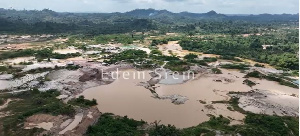Opinions of Tuesday, 20 September 2022
Columnist: Cameron Duodu
So, we cannot defeat galamsey?
A private legal practitioner, Mr. Kwame Adofo, is reported to have said that “galamsey cannot be defeated in Ghana” because our major political parties — that is, the New Patriotic Party (NPP) and the National Democratic Congress (NDC) — “will fight against each other” if one of them shows that it really intends “to defeat galamsey.”
It may be said that Mr. Adofo’s observation is an obvious one. Yes, a “national consensus” can achieve anything. But how does one bring a national consensus over an issue that is so dominated by money?
Nevertheless, what Mr. Adofo is saying raises the question, “Of what use will winning an election be to you if you and your supporters subsequently die because, by the time you win the election, the country’s water sources have all been destroyed?
Even if the technology exists to purify whatever tiny amounts of water remain in the rivers, streams and other water bodies, could you afford to purchase such technologies? What “levy” would you introduce to bring in the money needed and by what deceitful name would you designate it?
The only thing an honest government can do is to take the electorate into its confidence, explain matters in detail and – truthfully — and then ask for support. The NPP evolved a good programme against galamsey, called GALAMSTOP, but the programme was sabotaged by factions within the NPP itself.
Each ethnic group in Ghana has its own inherited system (though many overlap.) The system might be different but the objective is always the same, namely, safeguarding the welfare of the society at large. Nomenclatures and organisational structures may make them different from one another, but their methods of providing indigenous social insurance are always the same.
In the Akan societies, the body responsible for tackling emergencies is called the ASAFO, or KYIREM.
The Asafo is headed by an Asafohene, who sits at the apex of a structure that evolved along military lines. The most important elements of the structure include the drummers/gongong group dawubofuor and the intelligence-gathering group (Akwansrafuor).
The main body of the Asafo is the mass of MEN in the community. There is a song which warns young men that they should ready themselves for Asafo functions, by learning how to operate an Asafo. The song goes like this:
“Wowo WO benyinn’eseenkogoroasafoee,
Mmarimammera o!
[When you are born a male and you don’t practise how to operate in an asafo, one day, the call will come out for all “men” to come forward!]
In an emergency, the kyirem drums and gongongs are beaten, and each Elder summons his family members to meet him at his house. They talk there for a while, and then they all troop to the Chief’s palace or Ahenfie. This process is duplicated in each family, and they all troop to the palace, where they learn of the type of emergency that has occurred.
They discuss ways of tackling it. If they need tools or facilities that are not immediately available to them, they send word to the Chief, who might have some ideas. When they are satisfied that they have the means of combating the emergency, they set out for the bush. Their numbers give them confidence that they can tackle anything!
When I was a child I once saw this group in action. A woman called AfiaMframa went to her farm and getting towards nightfall, her kinsfolk noticed that she had not come back. There had been a storm earlier in the day, so the alarm was raised. (The family head went to tell the chief drummer of the Asafo and the drums were beaten.)
Within half an hour, the Chief’s palace had completely filled with people. Everyone who heard the particular Asafo drums that were played that afternoon knew that something “dangerous” had happened. The nature of the danger was spelt out openly at the palace and people from MaameAfiaMframa’s family were asked to lead the group to her farm.
It took them just about an hour to find her body – she had been struck down by the branch of a tree that had broken off, following the strong wind.
They picked up the body, wrapped it up and gave it to two young men from her family to carry. They then began singing war songs and came back to the village – to be met by everyone, including us children
The Asafo then divided itself into two groups – one to take the dead body to the mortuary at Kyebi, seven miles away, where there was also a Government police station, where the matter could be reported.
The Asafo was therefore the backbone of our entire traditionally democratic society. It was also through the Asafo that, if a Chief went against his oath to serve the interests of the people, public meetings could be held to bring him to order.
By undermining the Asafos, our past Governments abrogated our local democracy. And that is why, today, if a galamseyer gets the co-operation of a Chief (by paying him a secret “royalty”, he can muddy the waters enough for the galamseyer to operate unhindered.
The Chiefs have largely conned the Central Government into believing that the Asafos want to bring anarchy to their villages, and, of course, no Central Government welcomes such an eventuality.
The Central Government ought to help both the Chiefs and their people rediscover their past methods of cooperation, in order to save Ghana from a future in which our children and their grandchildren will have no safe water to drink.
There are a few Asafo groups which have retained their strength for years (such as those that catch deer at the Aboakyer festival of Winneba.) But even those are a shadow of themselves these days.
I strongly suggest the Central should set up a Commission of Enquiry immediately to look into the possibility of reviving the Asafos.
Entertainment










